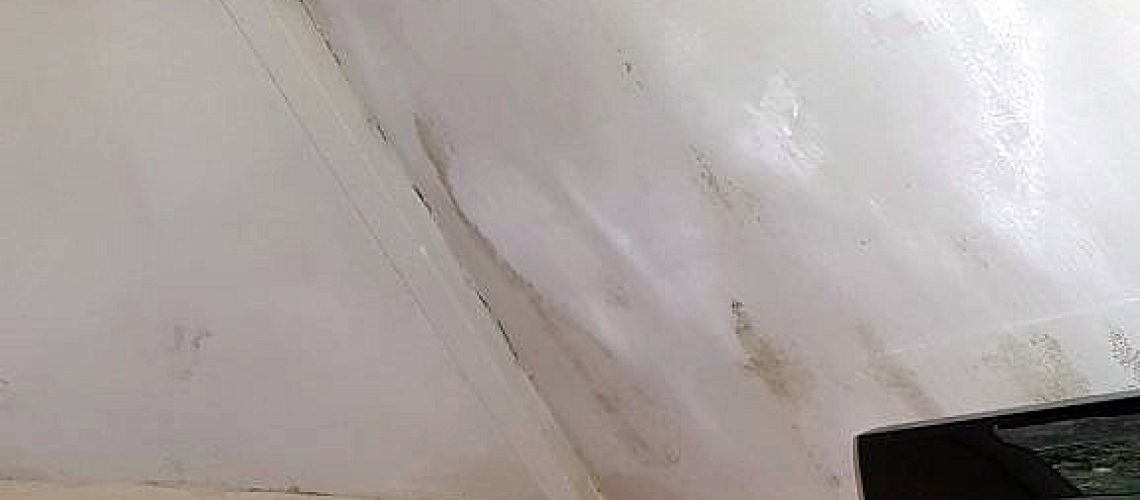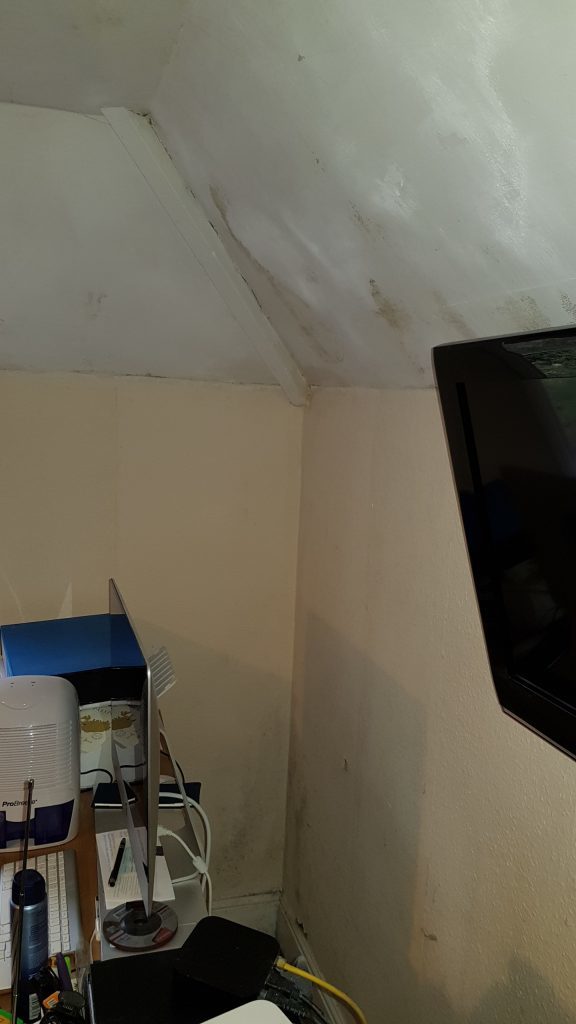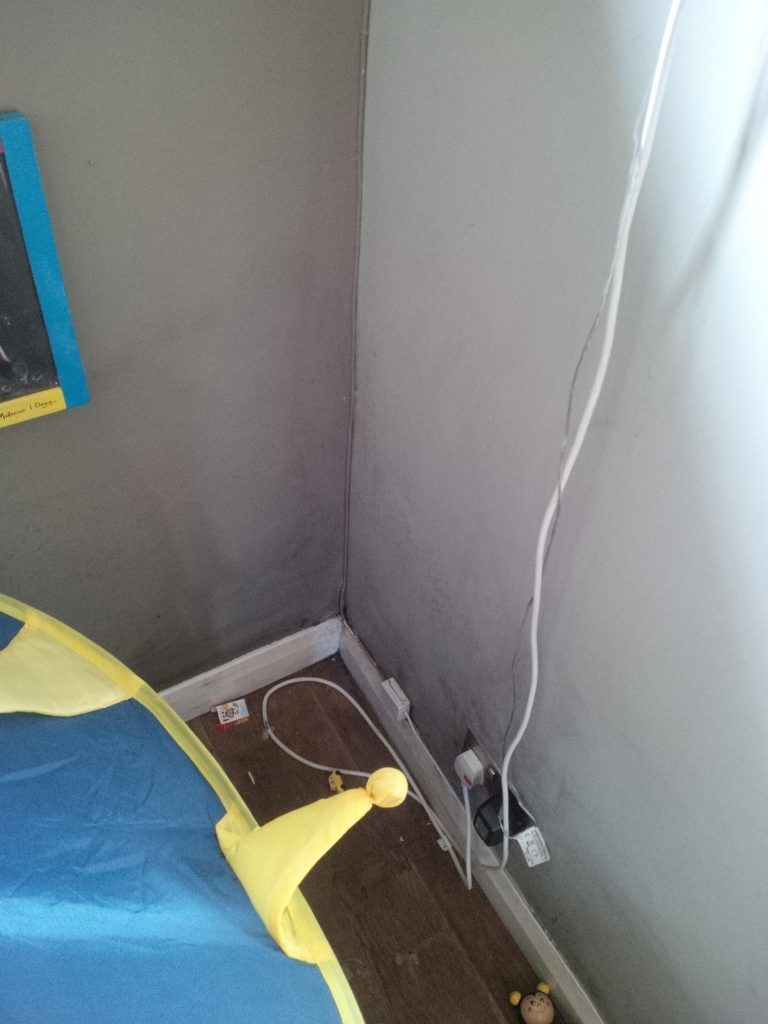


In the following article, Chartered Surveyor Stephen Boniface tackles the subject of condensation, including the issue of condensation mould, how condensation can be confused with rising damp, and what to do if you find these problems in your home.
In a previous article I discussed the myth of rising damp. I mentioned that whilst damp may occur very low in a wall it rarely, if at all, rises up the wall. Nonetheless, what appears to be ‘rising’ damp is usually another form of damp. I mentioned that rising damp was the most commonly misdiagnosed form of damp and yet the most common form is in fact condensation. In fact, damp identified as rising damp is often condensation. This article considers the issue of condensation and what a homeowner might be able to do to combat it.
A Consideration when dealing with condensation involves looking at temperature (of air and internal surfaces), absolute and relative humidity, thus leading to an assessment of dew point and an assessment of the likelihood of condensation occurring either on surfaces or within a structure. This can be quite complex, involving various pieces of equipment (e.g. temperature and humidity sensors, thermal imaging, etc.), as well as assessment and calculations that often have to be undertaken over time to gain a proper understanding of what moisture is doing in a building. The time of year will also affect the appearance of condensation damp and its assessment.
Nonetheless, this article is aimed at a homeowner and how a homeowner might be able to combat condensation.
Put quite simply warm air can absorb and hold water as a vapour whereas cold air cannot. If warm moist air meets a cold surface then it is forced to release that vapour as liquid (water), hence condensation. To compound problems if that moisture stays on a surface for any length of time the risk of mould occurring will increase.

The one key factor when considering condensation is the occupiers of the house. Most condensation problems can be traced back to what the occupier does or does not do, i.e. lifestyle. Our very presence will create moisture and daily life operations such as bathing, cooking, etc., will elevate moisture levels. If you have a habit of drying clothes inside this will simply add to the moisture in the property.
When considering condensation, the three issues that are usually considered are:
The most common problem is where an occupier creates warm moist air that does not escape from the property quick enough thus leading to condensation and mould problems. I have three daughters and when they lived at home a common problem was that they believed the bathroom was not a suitable environment to step into unless it was like a sauna. They would run the shower hot for a period of time before stepping into the bathroom. Upon completion they would leave the window closed (because they did not want to introduce cold air) but leave the bathroom door open while they got dressed. It was not long before the moisture in the air met the cold external wall and window surfaces and became condensation. The other problem with this is that leaving the bathroom door open meant that some of that warm moist air escapes into other parts of the building where it might then cause further condensation problems.
The above scenario is probably quite common in many houses up and down the country. The solution is quite simple. When finished in the bathroom the window should be opened and the door should be closed. This will mean that the warm moist air should escape out through the window. Of course, if you have an extractor fan fitted then this should be turned on to aid the evacuation of the warm moist air. In fact, all bathrooms, showers and kitchens should be fitted with extractors (suitably positioned) so that moist air is removed speedily.
In kitchens cooking can lead to excessive moisture in the atmosphere. I was once asked to investigate a problem of damp in a flat contained within a block of flats. As the door of the flat was opened the problem was immediately apparent. Before I had even stepped fully into the property the tropical atmosphere within caused my glasses to steam up. Upon entering I noted that the occupant had a couple of pans of water on the boil on the stove as he was in the process of cooking his daily meal. None of the windows were open and there was no extractor in use. It was no surprise that when this warm moist air met the external walls and windows of the flat that it became condensation. Because the occupant had not wiped that moisture clear it had become mould and there was a serious problem of mould to exterior walls and windows. Although the construction of the property did not help matters, the lifestyle of the occupant was clearly a major contributory factor if not the cause of the problem.
In another situation I was asked to investigate a house that had recently had double glazed windows installed. They had a problem of condensation moisture that had not previously existed. I advised them that there although they could insulate walls, etc., this would be expensive and disruptive with no guarantee that the problem would be resolved. However, I noted that the bathroom and kitchen already had extractor fans and recommended that they use these on a regular basis. I find that most extractors have isolation switches and in the vast majority of houses these remain turned off most of the time. This is often because of the noise of the fan! In the case of this house I noted that they had all the windows closed (and locked – for security). My advice, which went down badly, was that they should open the windows on a regular basis to allow the warm moist air to escape. Upon being told this they exclaimed that they did not want “to lose the heat from the windows now that they had spent a lot of money on having double glazing installed”.
A serious problem we face today is that many homes are being insulated and sealed to a degree that has not been known or indeed possible previously. This means that the air changes within a property are reduced and as a result warm moist air does not escape so quickly and the risk of a condensation problem increases significantly.
An example of air change problems came about some years ago when I was asked to investigate a problem of a damp smell in a ground floor flat within a converted Victorian building. The owners had recently had double glazing installed and they were a young couple who were both out at work all day. The problem was that when the owners returned home each evening the smell in the property was quite overpowering. I quickly realised that their lifestyle meant that in the morning they showered, had breakfast and prepared their meals for the day and then both left closing the door behind them. They left the property for perhaps eight to ten hours and when they returned home, having had double glazing installed, they were met by the same stale air that they had left. There were simply insufficient air changes in the day to change the atmosphere. In that particular instance the introduction of extractor fans to the kitchen and bathroom and advice to open windows as soon as they returned home did resolve the problem for them.
Earlier I mentioned the three factors that can influence matters.
The first of these is heating. It is important to ensure that a property has a reliable heating system of some description. The dew point is the point at which the temperature of air changes such that the air can no longer hold moisture as a vapour and has to release it. The actual temperature will vary depending on a number of factors. However, if temperatures within a property fluctuate considerably throughout any given day or over a period then the risk of hitting the dew point increases. If the temperature is more constant and kept above the dew point, then the risk of condensation is generally removed. Therefore, retaining a fairly constant temperature in a property is perhaps the Best way to avoid condensation. However, as the air temperature rises it can hold more moisture and the risk of condensation increases. As a general rule keep heating on, but low, at all times and generally it is thought that a sensible temperature range should be around 10-20°C.
Of course, this refers to air temperature and I earlier mentioned that surface temperature can have an important part to play in some buildings. This is certainly the case with some materials or elements within a building. If the temperature of some surfaces is particularly cold, then a risk of condensation remains. In some buildings it may be straightforward to provide insulation, but it is not always easy, is often expensive and therefore not an option. The issue of raising surface temperature to walls and other parts of the structure can be quite complex and for this it is best to seek professional advice. Inappropriate insulation could create rather than resolve a problem.
Windows in older buildings are single glazed and these might be a cold spot and therefore prone to condensation. Double glazing is an option for many buildings, and it can indeed increase the temperature of glass but does not completely preclude the risk of condensation because glass itself is a relatively cold material. With listed and older buildings, the installation of double glazing may not be an appropriate option and may not be permitted. As an alternative secondary glazing can provide an improvement in terms of reducing heat loss. In many ways secondary glazing can be more efficient that double glazing because the whole of the window opening is covered by a second layer of glass not just the panes themselves.
The one disadvantage of double or secondary glazing is that draughts are reduced, thus reducing the number of air changes in the property.
That said, the benefit of secondary glazing is that it can be removed when it is not required, e.g. during summer months. The main problem is that it is necessary to have other methods of ventilating the property and creating air changes.
When considering these matters, it must be borne in mind that wet surfaces are colder than dry surfaces. Therefore, if a section of wall is wet (for any reason) then it would be colder and more prone to condensation to the surface.
The next matter to consider is ventilation. This is perhaps the most important matter to consider when assessing condensation. I sometimes remind clients, who wish to keep their homes sealed up, that barns don’t suffer condensation because they are draughty open spaces with a lot of air circulation.
I have already discussed the use of extractor fans and opening windows. These are fairly straightforward and relatively cheap methods by which a property can be ventilated. It is important to use these to create air circulation and therefore air changes, which will help remove the warm moist air. Other simple things to consider include regular opening of cupboards (particularly wardrobes) to air inside and moving furniture away from walls. The aim being to avoid areas where air can become trapped. As previously mentioned, avoid drying clothes inside wherever possible, Condensation: Don’t add to moisture levels unnecessarily.
With a modern building, designed to keep heat in and minimise heat loss, there is an inbuilt problem of a lack of air change. Because of this a number of systems have been developed in recent years to ensure that the building has a constant supply of fresh air coming in and air changes generally. Certainly, with modern buildings whole house heat and ventilation systems are increasingly common. These can work well but will need to be properly maintained.
Talking of maintenance, it follows that any item in the property that needs maintenance should be looked at regularly. This will include the boiler and heating system as well as any extractors or other form of mechanical or electrical ventilation.
When considering extractor fans, I would point out that there are humidity-controlled extractors on the market. In situations where an occupier might forget to turn on an extractor or where there is a high humidity on a regular basis it might be appropriate to install a humidity sensor that will automatically trigger the extractor fan. There are also dehumidifiers available for domestic situations and these can be useful.
I have already touched upon the issue of insulation. Most homeowners are well aware of the need to insulate roofs. It is becoming rare to find a property that does not have adequate or some level of roof insulation.
The government have brought about schemes together with the energy companies whereby some home owners can benefit from having their Condensation in roof spaces insulated for free. Whilst this is of some benefit, I have noted a number of problems over the years where this scheme has been operated. The problems usually lie with the contractors installing the material. Quite often I see that the insulation is unevenly laid with serious gaps in some areas. I often see it laid in such a way that the insulation is in direct contact with the underside of the roof tiles or lining and this can result in problems of condensation moisture dripping down. The other problem is where a roof slope is lined there can often be insufficient ventilation in the roof space and condensation occurs in the area above the insulation.
When laying insulation care has to be taken with electrical services because you do not want these to be overheating. If there are walkways to water tanks or other areas in the roof these often need to be raised to allow the insulation to be placed underneath.
The one thing I have mentioned but not discussed is the surface insulation of walls. One can insulate from the exterior or from the interior. External insulation is more efficient because it covers the whole house – assuming it bridges to roof insulation so that there are no gaps in the insulation over the property. However, it can be expensive because it involves quite a lot of changes to the exterior. It creates a new wall surface that is beyond the face of the existing and therefore details such as windows and doors have to be changed as well as consideration given to matters such as the eaves of the roof. The application of an external system is often far more involved than simply putting insulation on the wall face. Nonetheless, if it can be installed it is often efficient at reducing heat loss.
Internal insulation is perhaps slightly easier to install because it can be dealt with during redecoration. However, internal insulation also changes the thickness of the wall and means that internal skirtings, windows and doors, etc might have to be altered. The other problem with internal insulation is that there will be a number of voids that are often forgotten and not insulated. Here I refer specifically to floor voids between the ground and first floor and these will form cold spots within the insulation.
If you are considering wall insulation the matter needs to be assessed properly so that the system once installed is beneficial and does not create problems. The other thing that needs very careful consideration is the type of insulating products. If they are impermeable, they could result in trapped moisture, as already mentioned. However, there are a range of permeable products that can be used and should not create a problem of trapped moisture.
There are materials within a structure that can act as cold spots; examples include concrete lintels over window and door openings. Sometimes condensation is found to occur to such areas but not elsewhere. It may be necessary to consider insulation of certain areas to reduce the cold spots. Again, this is something that needs to be carefully considered if such a problem exists.
Another scheme that has come about in recent years (from the government and energy companies) is the insulation of cavity walls. This could be the subject of a separate article but for now it is important to note that filling a cavity wall with anything means that it is no longer a cavity wall but a solid wall. The risk of moisture transferring from the outside to the inside increases but this will depend on the nature of the cavity insulation and how the work is undertaken. Another issue is that some materials used to fill cavities will lose their insulation values when wet whereas others do not. It has been found that in some locations in the country cavity insulation has created a problem of condensation. In those situations, the cavity insulation has had to be removed. Indeed, there are several companies that started off insulating cavities but have become specialists at removing cavity insulation because of such problems. Therefore, cavity insulation needs to be very carefully considered by a specialist who understands the issues and can specify the most appropriate product and method, or even be prepared to advise against it.
Although the issue of cavity wall insulation is one that is often pushed as a good thing, in my experience it is best avoided. Whilst there may be some advantage in terms of improved thermal retention it can be outweighed by the problems of damp it can cause.
The other major issue, as already mentioned, is that many insulation products are not ‘breathable’ and can result in trapped moisture. Before any insulation is applied to surfaces or cavities a holistic assessment should be undertaken.
It should be remembered that wet walls are cold and therefore more prone to condensation. As discussed above, the materials used can affect whether a wall remains dry or is wet. However, it follows that maintenance of a property is paramount, to ensure that dampness does not become a problem.
Most damp problems originate from a failure to maintain, or perhaps react to a defect with sufficient speed.
In this country perhaps the most important consideration for any building is keeping rainwater out. Regular checking of the exterior and dealing with timely repair, etc., will go a long way to prevent water problems internally that often then lead to condensation.

I have not so far discussed mould. Quite simply if condensation moisture is allowed to remain on a surface mould is likely to occur.
I am not a medical expert, but over the years I have learned that mould is not usually the primary cause of respiratory problems, but will exacerbate an existing respiratory problem, sometimes revealing a respiratory problem that the person did not realise they suffered. During a holiday to a humid location one of our daughters suffered breathing difficulties that were not experienced before and have not been suffered since. Humidity and mould that might result from condensation can have an impact on health that might be temporary but could be permanent.
Mould in any property is not good. If mould occurs, then it should be carefully removed with suitable detergents – there are many on the market designed to remove mould. Some paint and other finishes are designed to reduce the risk of mould occurring and might be useful in certain situations.
However, the best way of reducing the risk of mould becoming an issue is to ensure it cannot occur in the first place. Therefore, good ventilation will help air circulation, avoid high humidity and if condensation occurs remove the moisture quickly to stop the risk of mould growth. In situations where moisture occurs regularly the homeowner should make every attempt to remove it quickly. To some surfaces, this will be easier than others – at its simplest it might mean having an old towel to hand whereby the surfaces can be periodically wiped down.
The fact that what appears to be a damp problem is most commonly found at the base of a wall is no surprise. One must remember that because of gravity all forms of moisture will eventually work their way down a wall and could accumulate there. Because of this one must consider that just because the appearance of damp is at the base of a wall the damp may not be ‘rising’ at all.
In a previous article I argued that the base of a wall is most likely to have some damp in it; which may be absorbed from the ground, penetrate from the ground, made it’s way in from the exterior (rain, ground water, leaks from above, etc.,), etc. A wall that has moisture in it (for any reason) is going to be colder than a dry wall. As cold air falls anyway, the likelihood is that the coldest part of any wall will be at the base. In this article I have pointed out that if warm air meets a cold surface it will release the moisture when it reaches dew point. As the base of a wall is most likely to be colder than upper areas it follows that the base of a wall is a zone where condensation is likely to form. In my view damp at the base of a wall is more likely to be condensation and/or other forms of damp, but very rarely is it rising damp. Condensation must be considered as one of the most likely causes where damp appears at the base of a wall.
In summary:
This article cannot hope to deal with every aspect of condensation, dampness and the mould that can follow but hopefully give some guide as to the main issues and matters that a homeowner could consider if they find themselves with a condensation problem. Of course, if the problem is not one you are able to resolve you might need professional advice and here at Whitworth we are able to assist you in this regard.
Article Origin:
Stephen Boniface is a Chartered Surveyor at whitworth. Stephen has extensive experience in historic buildings and conservation work, and on a daily basis carries out a variety of work from surveys to expert witness.
